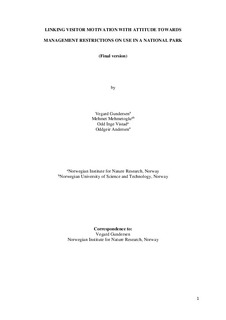| dc.contributor.author | Gundersen, Vegard | |
| dc.contributor.author | Mehmetoglu, Mehmet | |
| dc.contributor.author | Vistad, Odd Inge | |
| dc.contributor.author | Andersen, Oddgeir | |
| dc.date.accessioned | 2018-01-30T09:01:58Z | |
| dc.date.available | 2018-01-30T09:01:58Z | |
| dc.date.created | 2015-06-02T12:50:34Z | |
| dc.date.issued | 2015 | |
| dc.identifier.citation | Journal of Outdoor Recreation and Tourism. 2015, 9 77-86. | nb_NO |
| dc.identifier.issn | 2213-0780 | |
| dc.identifier.uri | http://hdl.handle.net/11250/2480551 | |
| dc.description.abstract | The increasing demand for visiting wilderness areas often requires management actions that both conserve the natural resources and ensure a high quality visitor experience. Many of the alpine national parks in southern Norway hold the last remaining populations of wild reindeer (Rangifer tarandus tarandus) in Europe. Therefore management needs more effective tools to reduce or remove recreational impact on wild reindeer populations. Management actions should also consult research-based knowledge on visitors. Therefore, this study explores the link between visitor motivations and their attitudes towards management actions on track-related (trail, path, trampling, track) and area-related (zoning, legal restrictions) use. The results show that two of the visitor motivations (i.e. hiking and place attachment) affect visitors’ attitudes towards management restrictions on use significantly. For instance, those visiting the national park for hiking are more positive to area-related restrictions while individuals attached to the place are more positive to track-related restrictions. Practical and theoretical implications are also discussed. | nb_NO |
| dc.language.iso | eng | nb_NO |
| dc.publisher | Elsevier | nb_NO |
| dc.rights | Attribution-NonCommercial-NoDerivatives 4.0 Internasjonal | * |
| dc.rights.uri | http://creativecommons.org/licenses/by-nc-nd/4.0/deed.no | * |
| dc.title | Linking visitor motivation with attitude towards management restrictions on use in a national park | nb_NO |
| dc.type | Journal article | nb_NO |
| dc.type | Peer reviewed | nb_NO |
| dc.description.version | acceptedVersion | nb_NO |
| dc.subject.nsi | VDP::Samfunnsgeografi: 290 | nb_NO |
| dc.subject.nsi | VDP::Human geography: 290 | nb_NO |
| dc.source.pagenumber | 77-86 | nb_NO |
| dc.source.volume | 9 | nb_NO |
| dc.source.journal | Journal of Outdoor Recreation and Tourism | nb_NO |
| dc.identifier.doi | 10.1016/j.jort.2015.04.004 | |
| dc.identifier.cristin | 1245860 | |
| dc.relation.project | Norges forskningsråd: 230335 | nb_NO |
| dc.description.localcode | © 2015. This is the authors’ accepted and refereed manuscript to the article. This manuscript version is made available under the CC-BY-NC-ND 4.0 license http://creativecommons.org/licenses/by-nc-nd/4.0/ | nb_NO |
| cristin.unitcode | 194,67,40,0 | |
| cristin.unitname | Institutt for psykologi | |
| cristin.ispublished | true | |
| cristin.fulltext | postprint | |
| cristin.qualitycode | 1 | |

